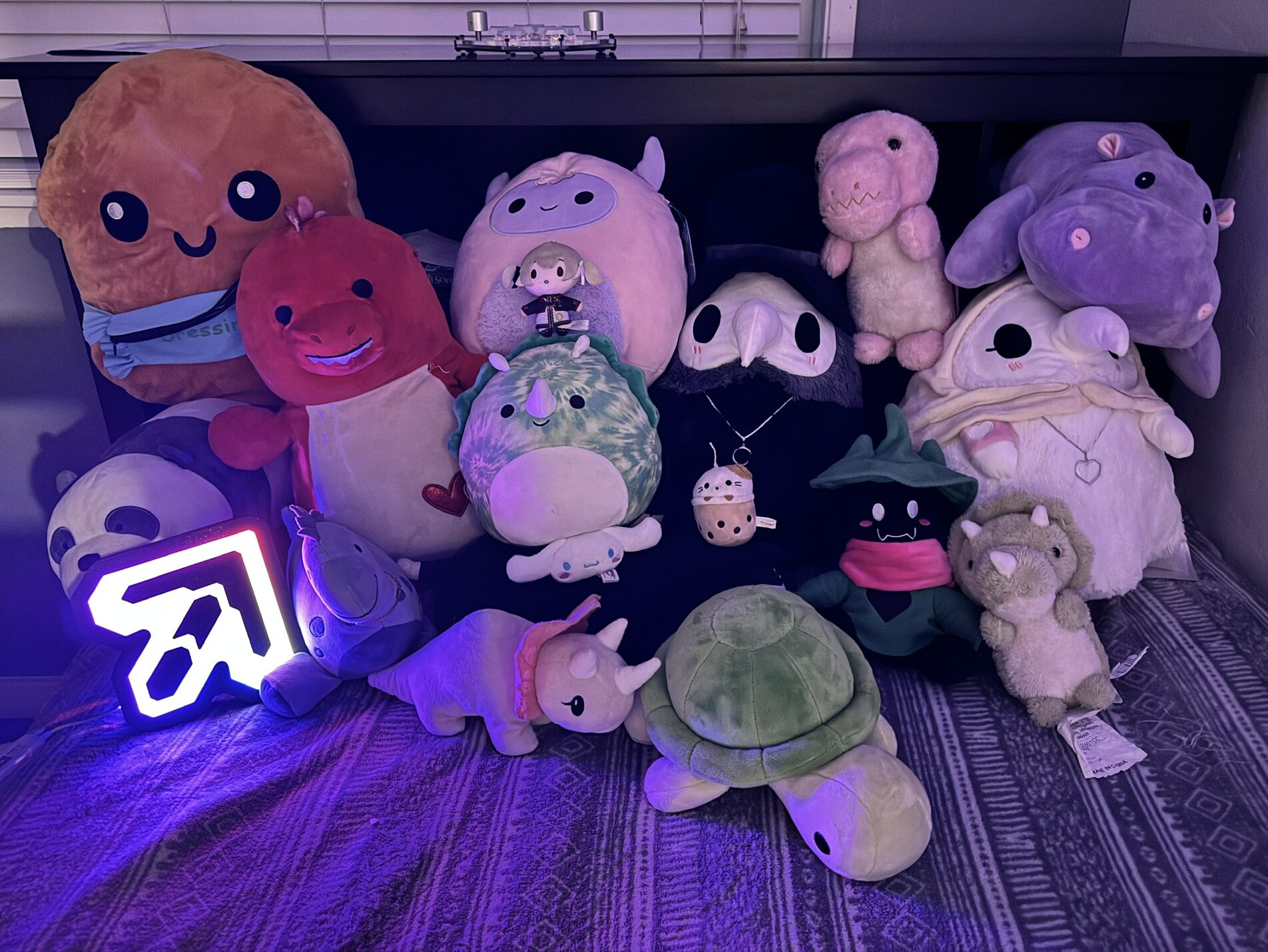What was once seen as a nerdy niche seemingly became a trendsetter overnight. From Beanie Babies to Squishmallows, stuffed toys and plushies have followed this cycle in pop culture with new fads coming and going. When did this trend cycle start, and when will the current plushie boom end?

Yuzumiin (via X/Twitter)
A collection of plushies compiled by interviewee Yuzumiin who has been collecting since since 2016.
Since the dawn of the stuffed toy, plushie companies have been devising the next big toy to kick start a bigger trend. Some attempts like the first Peter Rabbit in 1903 or Paddington Bear in the 1970’s saw success. However, none were even close to the reign of Ty’s Beanie Babies.
Released in 1995 amidst the roaring nineties, Ty Warner (CEO of Ty Inc.) was determined to create the perfect plush. “If you know in your heart it is a good idea, don’t give up or compromise on it,” Warner stated. Eventually it worked, and the plushies gained immense popularity.
Ty Inc. kept the flame burning with artificial scarcity. Since the start, variants were shipped out without regard to demand, thereby giving high value to certain variants. In the same debut year, Ty Inc. disguised a supply issue with one plush as a discontinuation and encouraged collectors to grab other variants on the chopping block.
Like an ouroboros though, greed only consumes itself. In 1999, Ty Inc. released 24 new beanie babies to the lineup that, according to Bowling Green State University, oversaturated and overwhelmed the market and their collectors. By Y2K, it was too late: The babies lost their appeal, and the huge markups dropped to their $5 retail price.
With one giant felled, this gave way for other plushie companies to take the throne. The foldable, cuddly Pillow Pets first took the spotlight in 2003, followed by the digital & interactive Webkinz in 2005. However, none have competed as much with Beanie Babies as Squishmallows have.
Initially released in 2017, it took Squishmallows until the latter half of 2020 to truly pick up steam. Since September 2020, Squishmallows slowly rose to a spike that reportedly tripled its sales and popularity. The main contributors? Both TikTok and the COVID-19 pandemic.
Many users in the “SquishTok” subsection of the platform loved to collect Squishmallows and upload said collections. According to The New York Times, collectors cite their comfort during the uncertain times of the pandemic as reason for collecting. Several collaborations, including ones with Sanrio and Pokemon, helped with bringing collectors in as well.
Thanks to their similarities in cuteness, Sanrio also had its biggest popularity. Hello Kitty along with other characters were constantly popular, of course, but usually fizzled out into a niche interest. That changed at the same time as Squishmallows, however, with a huge popularity spike at the same time.
Aesthetics were the biggest source of popularity, and in due time Hello Kitty was pushed out of the Sanrio spotlight by her coworkers. Characters like My Melody, Kuromi, Cinnamoroll, and Purin were perfectly-colored fits that took over every aesthetic frame. As they rose to the top, so did demand for their tangible versions – plushies.
Demand for plushies of said characters soared and have kept a steadfast growth even now. Japanese or not, any store or arcade with plushies is sure to have one of these characters. This popularity boom gave way for both new and seasoned collectors to unite and reignite their passions.
One such seasoned collector, who goes by Yuzumiin online, has been collecting plushies since 2016. Since getting her job, she’s amassed a massive collection of plushies that all sit at her bedside. “Whenever I look at my plushies, I feel comforted by them and also excited that my collection will keep growing,” Yuzu cites as her motivator.
This sentiment shared by collectors is one of the main reasons behind this plushie renaissance. During the troubling COVID-19 pandemic, plushies slowly lost their childish stigma as the general public sought out comfort in any form. Publications like TIME Magazine also agree that a generational shift took place here and brought these plushies back into the mainstream.
Once the public opened back up in mid-2021, plushie distributors moved onto their next weapon: crane games. While slumped in the US, crane games were on the rise in East Asia during the 2010’s. Companies like Sega and Taito made a wide variety of different crane games (known as UFO catchers due to their shape) that eventually came to the US via Japanese arcade chain Round 1.
“As of right now, crane games at Round 1 are my primary source for plushies,” Yuzu states. These crane games aren’t just normal cranes, but are instead minigames and challenges involving the crane to obtain a prize. “Sometimes they’re totally not worth it, but other times they’re just too easy,” she adds.
With plushie collaborations and remotely-controlled crane games on the rise, the plushie craze shows no signs of stopping anytime soon. As both become more internationally accessible, one is left to wonder: Has the craze already reached its peak, or is this only the beginning?

